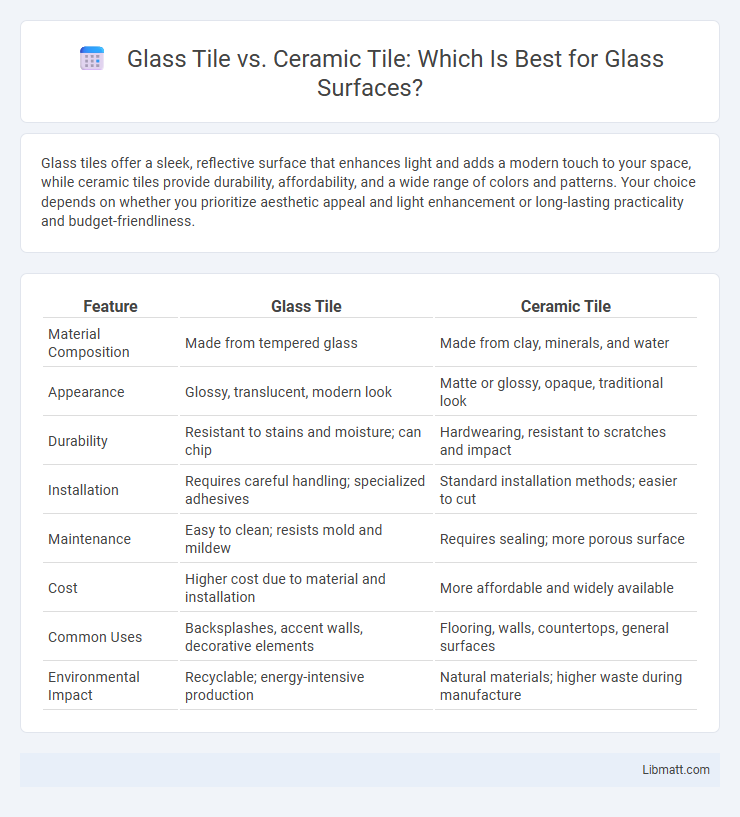Glass tiles offer a sleek, reflective surface that enhances light and adds a modern touch to your space, while ceramic tiles provide durability, affordability, and a wide range of colors and patterns. Your choice depends on whether you prioritize aesthetic appeal and light enhancement or long-lasting practicality and budget-friendliness.
Table of Comparison
| Feature | Glass Tile | Ceramic Tile |
|---|---|---|
| Material Composition | Made from tempered glass | Made from clay, minerals, and water |
| Appearance | Glossy, translucent, modern look | Matte or glossy, opaque, traditional look |
| Durability | Resistant to stains and moisture; can chip | Hardwearing, resistant to scratches and impact |
| Installation | Requires careful handling; specialized adhesives | Standard installation methods; easier to cut |
| Maintenance | Easy to clean; resists mold and mildew | Requires sealing; more porous surface |
| Cost | Higher cost due to material and installation | More affordable and widely available |
| Common Uses | Backsplashes, accent walls, decorative elements | Flooring, walls, countertops, general surfaces |
| Environmental Impact | Recyclable; energy-intensive production | Natural materials; higher waste during manufacture |
Introduction to Glass and Ceramic Tiles
Glass tiles offer a sleek, reflective surface made from tempered glass, providing vibrant color options and a modern aesthetic. Ceramic tiles are crafted from natural clay materials, fired at high temperatures, and feature a durable, matte or glossy finish ideal for versatile applications. Both tile types vary in durability, installation methods, and maintenance requirements based on their unique material properties.
Key Differences Between Glass and Ceramic Tiles
Glass tiles offer superior brightness and reflectivity due to their translucent nature, enhancing light distribution in spaces, whereas ceramic tiles provide greater durability and resistance to scratches and stains. Ceramic tiles are typically thicker and better suited for high-traffic areas, while glass tiles excel in decorative applications such as backsplashes and accent walls. Maintenance requirements differ, with glass tiles needing gentle cleaning to prevent damage, contrasting with ceramic tiles' easier upkeep and robust surface.
Appearance and Design Options
Glass tiles offer a sleek, reflective surface with vibrant color options and a glossy finish that enhances light and creates a modern aesthetic. Ceramic tiles provide a broader range of textures and patterns, often mimicking natural materials like stone or wood, giving you versatile design possibilities for any space. Your choice between glass and ceramic will depend on whether you prefer the luminous, contemporary appeal of glass or the classic, varied appearance of ceramic.
Durability and Lifespan Comparison
Glass tiles offer higher resistance to staining and water damage compared to ceramic tiles, making them ideal for moisture-prone areas like bathrooms and kitchens. Ceramic tiles provide superior impact resistance and are less prone to chipping and cracking under heavy foot traffic, which contributes to a longer lifespan in high-traffic spaces. Both tile types generally last 20 to 50 years depending on installation quality and maintenance, but glass tiles often require more careful handling to avoid breakage, while ceramic tiles boast greater overall durability.
Water and Stain Resistance
Glass tile offers superior water and stain resistance compared to ceramic tile due to its non-porous surface, making it less prone to moisture absorption and easier to clean. Ceramic tile, while water-resistant, can absorb water through grout lines and may require sealing to prevent stains and damage. Choosing glass tile for areas prone to moisture ensures your surfaces stay cleaner and maintain their appearance longer.
Ease of Installation and Maintenance
Glass tile offers a smooth surface that makes installation more challenging due to its slippery nature and higher fragility compared to ceramic tile, which is denser and easier to cut and handle. Maintenance-wise, glass tiles resist stains and mold better, requiring less frequent cleaning, while ceramic tiles may need more regular sealing and grout upkeep to prevent discoloration. Your choice depends on whether you prioritize hassle-free installation with ceramic tile or long-term low-maintenance benefits with glass tile.
Cost Comparison: Glass Tile vs Ceramic Tile
Glass tile generally costs more than ceramic tile, with prices ranging from $15 to $30 per square foot compared to ceramic tile's $1 to $15 per square foot. Installation expenses for glass tile tend to be higher due to specialized labor and materials needed to avoid damage. Your budget may influence the choice between the premium cost of glass tiles and the more affordable ceramic options.
Best Applications for Glass Tiles
Glass tiles excel in applications where aesthetic appeal and light reflection are paramount, such as kitchen backsplashes, bathroom walls, and shower enclosures. Their non-porous surface resists stains and moisture, making them ideal for wet environments while adding a vibrant, glossy finish. You can enhance your space with glass tiles for modern, elegant designs that brighten smaller or darker areas.
Best Uses for Ceramic Tiles
Ceramic tiles are best suited for high-traffic areas like kitchens and bathrooms because of their durability, water resistance, and ease of maintenance. These tiles perform well on floors, walls, and backsplashes, providing long-lasting strength and aesthetic versatility. Your choice of ceramic tiles supports practical, cost-effective renovations with a wide range of styles and finishes.
Eco-Friendliness and Sustainability
Glass tiles are often more eco-friendly than ceramic tiles due to their high recycled content, commonly made from post-consumer and post-industrial glass, reducing landfill waste. Ceramic tiles require extensive energy in firing clay at high temperatures, resulting in a larger carbon footprint compared to the lower energy recycling process in glass tile production. Both materials are durable and long-lasting, but glass tiles offer a more sustainable option when prioritizing recycled materials and resource conservation.
Glass tile vs ceramic tile Infographic

 libmatt.com
libmatt.com